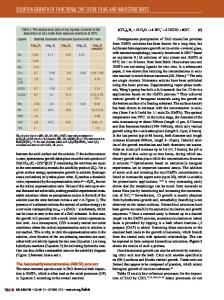Growth of Zinc Oxide Nanorods in Alocohol Solution
- PDF / 899,200 Bytes
- 4 Pages / 612 x 792 pts (letter) Page_size
- 77 Downloads / 366 Views
P9.43.1
GROWTH OF ZINC OXIDE NANORODS IN ALOCOHOL SOLUTION Richard D. Yang, Yuntao Li, and Hung-Jue Sue Polymer Technology Center, Dept. Mech. Eng., Texas A&M University, College Station, TX 77843-3123 ABSTRACT Zinc oxide (ZnO) nanorods have been grown by hydrolyzing Zn(OAc)2•2H2O in methanol solution. Nanoparticles in sizes ranging from 2 to 4 nm were first obtained at low concentration. The growth kinetics was monitored by UV-vis absorption spectroscopy. The precursor was then concentrated by 10 folds and refluxed at 600C for 24 hours to form ZnO nanorods with an aspect ratio of 12. Ligand adsorption growth model was proposed to explain the anisotropic growth.
INTRODUCTION ZnO-based materials have attracted enormous attention in recent years because of their exotic properties and versatile applications [1]. ZnO nanoparticles have been successfully prepared in alcohol solution by various groups [2-5]. Nanorods growth has also been studied by some groups [6-8]. However the shape control mechanism is still not well understood and, thus, limiting their potential applications. Herein we adapt a method by Pacholski et al, which can give high yield for nanorods formation in a surfactant free condition. The growth process from nanodots to nanorods was monitored by absorption spectroscopy and transmission electron microscopy (TEM). Our work aims at understanding the anisotropic crystal growth mechanism and establishing well-controlled growth process of ZnO nanorods.
EXPERIMENTAL DETAILS ZnO nanoparticles preparation Zn(OAc)2 and KOH solution were prepared by dissolving Zn(OAc)2 dihydrate and KOH in methanol. Freshly prepared 0.01M Zn(OAc)2 solution (26ml) was refluxed in oil bath at 650C under vigorous stirring for 15 minutes. Subsequently, 0.03M KOH solution (50ml) was added drop-wise under stirring [7]. Optical property characterization The UV-vis absorption and fluorescence properties of the nanoparticles were monitored by HP 8451 diode array spectrophotometer and SLM Aminoco MC200 spectrofluorometer. Nanorods growth The solution was concentrated 10 folds by rotary evaporation at room temperature within 10 minutes and then refluxed at 600C for 24 hours.
Downloaded from https:/www.cambridge.org/core. University of Arizona, on 06 Apr 2017 at 22:35:22, subject to the Cambridge Core terms of use, available at https:/www.cambridge.org/core/terms. https://doi.org/10.1557/PROC-775-P9.43
P9.43.2
TEM samples were prepared by evaporating the nanoparticle solution on carbon-coated copper grids. Images and electron diffraction patterns were taken using JEOL JEM-2010 TEM operating at 200 kV.
DISCUSSION Hydrolysis of Zinc Acetate in methanol can yield ZnO nanoparticles at relative high concentration and short time when compared to other synthesis methods [3,9]. Nanoparticles can be formed after 5 minutes in methanol solution, as observed from absorption spectrum (Fig. 1). The particle grew progressively in size over the time of refluxing. The particle grew to 2.6 nm in diameter, as measured by TEM, after 2 hours in solution.
Data Loading...











